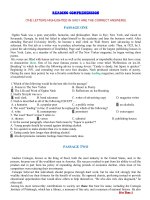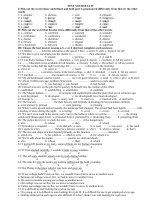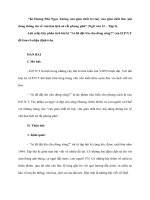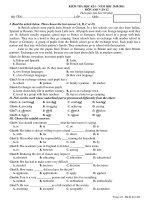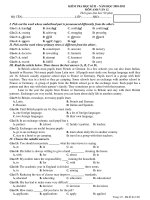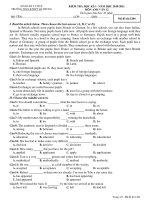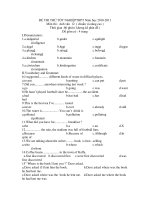Đọc Hiểu Anh Văn 12 NC I
Bạn đang xem bản rút gọn của tài liệu. Xem và tải ngay bản đầy đủ của tài liệu tại đây (157.24 KB, 8 trang )
READING COMPREHENSION
(THE LETTERS HIGHLIGHTED IN GREY ARE THE CORRECT ANSWERS)
PASSAGE ONE
Ogden Nash was a poet, storyteller, humorist, and philosopher. Born in Rye, New York, and raised in
Savannah, Georgia, he tried but failed to adapt himself to the academic and later the business world. After
attending Harvard University briefly, he became a mail clerk on Wall Street, later advancing to bond salesman.
His first job as a writer was to produce advertising copy for streetcar cards. Then, in 1925, he 5. joined the
advertising department of Doubleday Page and Company, one of the largest publishing houses in New York.
Later, as a member of the editorial staff of The New Yorker magazine, he began writing short poems.
His verses are filled with humor and wry wit as well as the unexpected or improbable rhymes that have come to
characterize them. One of his most famous poems is a two-line verse titled "Reflections on lce-iO. Breaking" in
which he offers the following advice to young lovers: "Candy is dandy, but liquor is quicker." Beginning in
1931, and extending over the next four decades, Nash produced nineteen books of poetry. During the same time
period, he was a favorite contributor to many leading magazines, and his name became a household word.
1. Which of the following would be the best title for the passage?
A. Poems in The New Yorker B. Humor in Poetry
C. The Life and Work of Ogden Nash D. Reflections on Ice-Breaking
2. Nash's first job was as a
A. mail clerk B. bond salesman C. writer of advertising copy D. magazine writer
3. Nash is described as all of the following EXCEPT …
A. a humorist B. a popular poet C. a prolific writer D. an alcoholic
4. The word "leading" in line 12 could best be replaced by which of the following?
A. witty B. contemporary C. prominent D. extravagant
5. The word "them" in line 9 refers to
A. rhymes B. verses C. editorial D. publishing houses
6. In the second paragraph, what does Nash mean by "liquor is quicker"?
A. Young people should be warned against drinking alcohol.
B. It is quicker to make alcohol than it is to make candy.
C. Eating candy lasts longer than drinking alcohol.
D. Alcohol promotes romantic feelings faster than candy does.
PASSAGE TWO
Andrew Carnegie, known as the King of Steel, built the steel industry in the United States, and, in the process,
became one of the wealthiest men in America. His success resulted in part from his ability to sell the product and
in part from his policy of expanding during periods of economic decline, when most of his competitors were
reducing their investments.
Carnegie believed that individuals should progress through hard work, but he also felt strongly that the wealthy
should use their fortunes for the benefit of society. He opposed charity, preferring instead to provide educational
opportunities that would allow others to help themselves. "He who dies rich, dies disgraced," he often said.
Among his more noteworthy contributions to society are those that bear his name, including the Carnegie
Jnstitute of Pittsburgh, which has a library, a museum of fine arts, and a museum of national history. He also
founded a school of technology that is now part of Carnegie-Mellon University. Other philanthrophic gifts are
B o Thoa ả 1
the Carnegie Endowment for International Peace to promote understanding between nations, the Carnegie
Institute of Washington to fund scientific research, and Carnegie Hall to provide a center for the arts.
Few Americans have been left untouched by Andrew Carnegie's generosity. His contributioas of more than five
million dollars established 2.500 libraries in small communities throughout the country and formed the nucleus
of the public library system that we all enjoy today.
1. With which of the following topics is the passage primarily concerned?
A. The establishment of the public library system B. The work of Carnegie-Mellon University
C. The building of the steel industry D. The philanthropy of Andrew Carnegie
2. How many libraries did Carnegie establish for the public library system?
A. 25 B. 500 C. 2,500 D. Five million
3. The author mentions all of the following as recipients of philanthropic contributions by Carnegie EXCEPT..
A. the arts B. technology C. economics D. science
4. The word "fortunes" in line 6 could best be replaced by…
A. assets B. talents C. influence D. advice
5. The word "those" in line 9 refers to …,,,,,,,,,,,,,,,,,,,,,,,,,,,,,,,,,,,,,,,,,,,,,,,,,,,,,,,,,,,,,,,,,,,,,,,,,,
A. opportunities B. contributions C. others D. themselves
6. In the second paragraph, what does Carnegie mean when he says, "He who dies rich, dies disgraced"?
A. Rich people should be ashamed of their money.
B. Rich people should use their money for the benefit of society before they die.
C. Rich people often live disgraceful lives.
D. People should try to become rich before they die.
PASSAGE THREE
Persons sixty-five years and over already represent 13 percent of the totaJ population in America, and by 2025
there will be 59 million elderly Americans, representing 21 percent of the population of the United States.
Furthermore, the percentage of the population over age eighty-five will increase from about 1 percent currently
to 5 percent in 2050. This population trend has been referred to as the graying of America.
To explain this demographic change, we must look to three factors. Fertility, mortality, and immigration in large
pan influence all demographic trends. The large number of children born after World War II will increase the
pool of elderly between 2010 and 2030. The "baby boom" will become the "senior boom" sixty-five years later.
Although the birth rate is the most dramatic factor, the decline in the death rate is also significant. Medical
advances have influenced life expectancy. For example, whereas only 40 percent of those Americans born in
1900 had a life expectancy of sixty-five, today 80 percent are expected to reach the classic retirement age. The
average male life span, now 71.4 years, is expected to increase to 73.3 by 2005. Among females, the life span is
projected to increase from the current 78.3 years to 81.3 years by 2005. In addition, immigration has contributed
to the increasing number of elderly. After World War I, a massive immigration of young adults of child-bearing
age occurred. Because the birth rates among this specialized population were very high, their children, now
among the elderly, are a significant segment of the older population.
1. Which of the following would be the best title for the passage?
A. The Graying of America B. immigration Patterns in America
C. Trends in Life Expectancy D. Baby Boomers
2. The average life expectancy for an American woman today is …
A. 71.4 years B. 73.3 years C. 78.3 years D. 81.3 years
3. The author mentions all of the following as factors that have influenced population trends EXCEPT
A. the "baby boom" after World War II B. the immigration after World War I
C. the improvements in health care D. the decline in the birth rate among young Americans
4. The word "pool" in line 7 refers to …
B o Thoa ả 2
A. a group of people B. a general direction C. a negative attitude D. an increase in influence
5. The word "their" in line 15 refers to
A. females B. elderly C. young adults D. birth rates
6. It can be inferred from the passage that the word "gray" is a reference to …
A . the color hair typical of older people
B. the last name of the person who has studied the population trends
C. the diversity of colors in the population that mix to make gray
D. the dismal outlook for the future because of population trends
PASSAGE FOUR
Whether one is awake or asleep, the brain emits electrical waves. During wakefulness, the waves are recorded
at about ten small waves per second. With the onset of sleep, the waves become larger and slower. The largest,
slowest waves occur during the first three hours of sleep. Mental activity slows down but does not stop. In fact,
if awakened from slow-wave sleep, a person can often remember vague thoughts that occurred during that
period of sleep.
During sleep, intervals of small, fast waves also occur. These waves are similar to those experienced while
awake. The eyes move rapidly, and it appears to the observer that the sleeper is watching some event. Sleepers
who are awakened during this rapid-eye-movement sleep will often recall the details of dreams they have been
having. Sleep of this kind is called dreaming sleep or rapid-eye-movement sleep, also known as REM sleep.
In a period of eight hours, most sleepers experience from three to five instances of REM sleep. Each instance
lasts from five to thirty minutes with an interval of at least ninety minutes between each one. Later instances of
REM sleep are usually of longer duration than are instances earlier in the eight-hour period.
People who suffer sleep deprivation experience fatigue, irritability, and loss of concentration. Sleep is essential
because it regenerates the brain and the nervous system. Slow-wave sleep may be especially helpful in restoring
muscle control, whereas REM sleep may be more important for mental activity. It appears that both kinds of
sleep are necessary, and the recuperation of sleep of one kind will not compensate for a lack of the other kind of
sleep.
1. What is the author's main purpose in the passage?
A. To describe REM sleep B. To explain sleep deprivation
C. To discuss the two types of sleep D. To recommend an increase in the number of hours of sleep
2. How many times per night do most sleepers experience REM sleep?
A. Eight B. Three to five C. Five to thirty D. Ninety
3. The author mentions all the following as characteristics of REM sleep EXCEPT …
A. vague thoughts B. smaller brain wavesC. eye movements D. dreams
4. The word "vague" in line 4 could best be replaced by
A. familiar B. indefinite C. unpleasant D. detailed
5. The word "it" in line 14 refers to …
A. deprivation B. the brain C. sleep D. concentration
6. It can be inferred from the passage that students who are writing term papers
A. require slow wave sleep to increase mental activity
B. can stay up all night working and recover the sleep they need by sleeping for a few hours the next afternoon
C. need REM sleep to restore mental functioning
D. do not need as much sleep because of the heightened brain waves involved in creative activity
PASSAGE FIVE
B o Thoa ả 3
In the United States today there are more than half a million criminals serving time in prison. Most prisoners are
male high-school dropouts between the ages of 18 and 29. Even more shocking is the fact that the number and
rate of imprisonment has more than doubled over the past twenty years, and the recidivism—that is, the rate for
rearrest—is more than 60 percent.
Although the stated goal of most prison systems, on both federal and state levels, is to rehabilitate the inmates
and reintegrate them into society, the systems themselves do not support such a result. Prisons are usually
geographically or psychologically isolated and terribly overcrowded. Even in the more enlightened prisons, only
one-third of the inmates have vocational training opportunities or work release options.
If prisons are indeed to achieve the goal of rehabilitating offenders, then the prisons themselves will have to
change. First, they will have to be smaller, housing no more than five hundred prisoners. Second, they will have
to be built in or near population centers with community resources available for gradual reintegration into
society. Finally, prison programs must be restructured to include work release and vocational and academic
training that promises carry over into the inmate's life after release. Models for such collaborative efforts
between the criminal justice system and the community already exist in several hundred half-way houses
throughout the country.
1. What is the author's main point?
A. Prisons must be restructured if they are to accomplish the goal of rehabilitation.
B. Models for community collaboration have been successful.
C. Most of the criminals serving time inprison are high-school dropouts.
D. The criminal justice system must establish a better goal.
2. According to the author, how many prisoners are offered training or work release?
A. None B. 33
1/
2
percent C. 50 percent D. 60 percent
3. The author mentions all the following as necessary to prison reform EXCEPT …
A. newer buildings B. smaller institutions
C. vocational training D. collaboration with the community
4. The word "recidivism" in line 3 refers to
A. all people who are imprisoned B. people who return to prison after release
C. people who drop out of high school D. people who have been in prison for a long
5. The word "them" in line 6 refers to …
A. prison systems B. inmates C. goals D. levels
6. The paragraph following this passage most probably discusses
A. the goals of most state and federal prisons B. the cost of prison reform
C. examples of models for community collaboration D. problems with the current criminal justice system
PASSAGE SIX
Standard usage includes those words and expressions understood, used, and accepted by a majority of the
speakers of a language in any situation regardless of the level of formality. As such, these words and expressions
are well defined and listed in standard dictionaries. Colloquialisms, on the other hand, are familiar words and
idioms that are understood by almost all speakers of a language and used in informal speech or writing, but not
considered appropriate for more formal situations. Almost all idiomatic expressions are colloquial language.
Slang, however, refers to words and expressions understood by a large number of speakers but not accepted as
good, formal usooage by the majority. Colloquial expressions and even slang may be found in standard
dictionaries but will be so identified. Both colloquial usage and slang are more common in speech than in
writing.
Colloquial speech often passes into standard speech. Some slang also passes into standard speech, but other
slang expressions enjoy momentary popularity followed by obscurity. In some cases, the majority never accepts
certain slang phrases but nevertheless retains them in their collective memories. Every generation seems to
require its own set of words to describe familiar objects and events.
B o Thoa ả 4
It has been pointed out by a number of linguists that three cultural conditions are necessary for the creation of a
large body of slang expressions. First, the introduction and acceptance of new objects and situations in the
society; second, a diverse population with a large number of subgroups; third, association among the subgroups
and the majority population.
Finally, it is worth noting that the terms "standard," "colloquial." and "slang" exist only as abstract labels for
scholars who study language. Only a tiny number of the speakers of any language will be aware that they are
using colloquial or slang expressions. Most speakers of English will, during appropriate situations, select and use
all three types of expressions.
1. With which of the following topics is the passage primarily concerned?
A. Standard speech B. Idiomatic speech
C. Different types of speech D. Dictionary usage
2. How is slang defined by the author?
A. Words and phrases accepted by the majority for formal usage
B. Words and phrases understood by the majority but not found in standard dictionaries
C. Words and phrases that are understood by a restricted group of speakers
D. Words and phrases understood by a large
number of speakers but not accepted as formal usage
3. The author mentions a!l of the following as requirements for slang expressions to be created EXCEPT
A. new situations B. a new generation
C. interaction among diverse groups D. a number of linguists
4. The word "appropriate" in line 5 could best be replaced by …
A. suitable B. congenial C. elegant D. direct
5. The word "them" in line 12 refers to
A. words B. slang phrases C. memories D. the majority
6. It can be inferred from the passage that the author
A. does not approve of either slang or colloquial speech in any situation
B. approves of colloquial speech in some situations, but not slang
C. approves of slang and colloquial speech in appropriate situations
D. does not approve of colloquial usage in writing
PASSAGE SEVEN
Edgar Allan Poe is today regarded as one of the premier authors of horror stories, but he received very little
recognition and almost no money for his stories while he lived. Twenty-five of his greatest stories were
published in a collection called Tales of the Grotesque and Arabesque, which appeared in 1840, but at the time
little notice was taken of it. Three years later, another story, 'The Gold Bug," was published, selling 300.000
copies, and by 1845 he had written twelve more stories, which he published in Tales. His best-known stories
include "The Pit and the Pendulum" and "The Tell-Tale Heart." But it was a poem, "The Raven," that brought
him his greatest recognition as a writer. The centerpiece of a collection of thirty poems published in a volume
titled The Raven and Other Poems, it became quite popular. The theme of the poem is grief over the loss of an
ideal love. The dramatic, almost theatrical tone, the intensity of the repetition, and the hypnotic rhythm reflect
the narrator's despondent and desperate state of mind. When read aloud, it produces a powerful effect.
1. What is the author's main purpose in this passage?
A. To give examples of horror stories B. To chronicle the work of Edgar Allan Poe
C. To compare Poe's stories with his poems D. To suggest that "The Raven" be read aloud
2. According to the passage, which of the following tales sold 300,000 copies?
A. 'The Tell-Tale Heart" B. 'The Gold Bug" C. "The Raven" D. 'The Pit and the Pendulum"
3. The author mentions all of the following as features of 'The Raven' EXCEPT
B o Thoa ả 5

